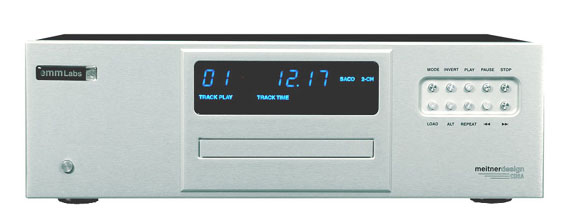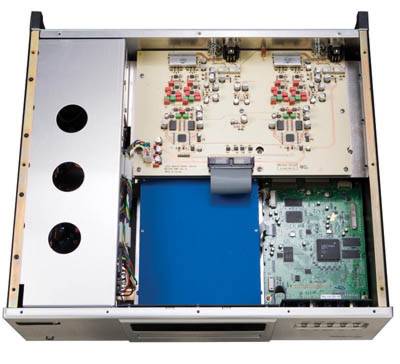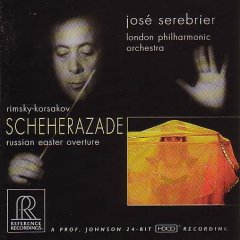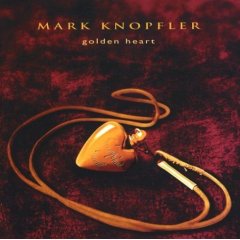EMM LABS CDSA SE CD/STEREO SACD PLAYER
| EMM LABS CDSA SE CD/STEREO SACD PLAYER |
|
|
|
March 2008 |

“Life without music is unthinkable. Music without life is academic. That is why my contact with music is a total embrace.”
Leonard Bernstein
At a recent Friday afternoon concert in Boston’s Symphony Hall, Sir Colin Davis conducted Mozart’s Piano Concerto No. 23 in A, K. 488 with pianist extraordinaire, Mitsuko Uchida. The A major is a softly glowing piece with a second movement of deep rich color and melancholy followed by a third movement of great joy and exuberance. The spectrum of colors and delicate touch that Ms. Uchida brought to her piano in this piece was something to behold. For example, in the contemplative Second Movement, she paused and lingered to allow the sounds of her soft, luminescent touch to reverberate in the golden ambience of Symphony Hall. This contrasted with the swirling Third Movement, where Ms. Uchida displayed swift and clean runs up and down the piano, pouncing on the joyous melody and then exchanging it delightfully with the orchestra. Watching the interaction of Sir Davis with Ms. Uchida was also a special treat. Sir Davis gave the pianist every opportunity to slowly reveal her piano lines and colors, offering her lengthy pauses (with a twinkle in his eye) for the inventiveness of Mozart to be unveiled in every delicate turn of phrase. Sir Davis kept time with his baton in his right hand, while his left hand gestured freely to elicit colors, textures and punctuations from Mozart’s score. At one point, Sir Davis elicited smiles from the string section (and the audience) when he made a rapid circular digging motion with his left hand (like a cat clawing at air) directed at the violin section to punctuate the upswing tempo to one of Mozart’s jovial motifs. In the gentle Second Movement, he brought his left hand up ever so slowly in a rising curlicue to punctuate the conclusion to a vanishing trill held by the woodwinds. In these and many other gestures, Sir Davis brought the orchestra and soloist together as one partner to flesh out the inner details, fresh colors and dynamic nuances from Mozart’s inventive score.
First Stanza
Upon returning home from this joyful performance to listen to this same Mozart Piano Concerto recorded on CD (this time played by the dynamic Imogen Cooper and Northern Sinfonia recorded in the Sage Gateshead in London [Avie Records 2100]), I was struck with how the new EMM Labs CDSA SE (“CDSA”) player takes its inspiration from the work of great conductors in bringing musical scores to life. Leonard Bernstein once commented that “technique is communication: the two words are synonymous in conductors.”I would guess that the remarkable Ed Meitner, the founder of EMM labs, has taken some inspiration from the great conductor’s quote in his design of the CDSA, a single box, dual format (CD/stereo SACD/MP3) player. Since 1998, EMM Lab’s team of engineers and associated musicians have developed some of the world’s most renown digital signal processing systems and equipment, including of course, the DSD converter system upon which the current production of SACD relies. In my recent conversations with the affable Meitner, he mentioned that he has always been driven in his work by an interest in Sound and its faithful communication. Meitner went on to explain that his goal is not for his digital processing components to sound their best within a limited musical genre. Rather, his ultimate design goal is the faithful reproduction of the Sound of any given recording so that any genre of recorded music, from Liszt to Lightning Hopkins, could be enjoyed equally.
Meitner emphasized in our conversations that in the realm of digital processing, the goal of unerring faithfulness to Sound begins and ends with a designer’s choice of a converter system (and its converter chips) that form the very heart of a digital player. For the new CDSA player, Meitner and his team developed two breakthroughs in this critical area of converter design. First, there is the Meitner Digital Audio Translator (“MDAT”) a new way of addressing digital signal processing. With MDAT, the CDSA takes a 44.1kHz signal of a typical CD and upsamples it to double the SACD standard sampling rate, or 5.6448MHz. This is done by the MDAT system dynamically adapting to the transient nature of a musical signal, rather than addressing it as a series of sine waves, (as is standard convention). With MDAT, EMM Labs claims they have achieved a better way of signal processing, preserving the phase, frequency and dynamic integrity of the original musical signal and moving the sound of CD’s much closer to that achieved with SACD playback. Second, the CDSA incorporates the world’s first discrete dual differential D-to-A conversion circuit, developed and produced entirely in house (including all converter chips and circuitry).

The CDSA also incorporates composite laminate circuit boards that are composed of microscopically smooth copper traces (to reduce skin effects) and naturally damped sandwich construction. On its nicely proportioned exterior, the CDSA provides all of the functions that one would require of a reference multi format player. These include balanced and unbalanced stereo analog outputs; an AES/EBU output to connect to an external D/A converter and switches for selecting high or low level for analog outputs, inverting polarity and choosing between CD and stereo SACD playback when playing hybrid SACDs. The remote provided is of a slim, ergonomic design with all of these same functions easily accessible. The rear panel houses a USB port for upgrades, and during the period of my audition, EMM Labs provided me with their latest software upgrade that was downloaded to the CDSA within minutes. (This software upgrade took the CDSA to another level of sonic performance, detailed below). EMM Labs should be commended for their commitment to software upgrades for the CDSA through their easily navigated website, and such a feature only adds to the player’s superb value. The CDSA was well built overall, although I did have a minor quibble with its use of a plastic drawer for disc placement. Other than that, the CDSA functioned impeccably during my audition, reading every disc promptly and operating with smooth, quiet efficiency.
Exposition
The essence of the CDSA’s sonic virtues, ones that set it apart from every other digital player I have heard to date, was its uncolored liquid presentation of the Sound offered on any CD or stereo SACD recording, mining the colors, textures and inner drama of any given recorded performance for all its worth. Some might find the CDSA’s neutrality a bit on the cool tonal side. However, the more I listened, the more I concluded that the CDSA’s uncolored presentation was offering me a new lesson in transparency to what lay on my favorite recordings, for better or worse. Listening to the CDSA was like taking a clear magnifying glass to a snowflake and observing its crystalline structure anew, with all of its inner texture, complexity of pattern and reflections of light before it swiftly melted away. On the finest recordings, it offered a delicious slice of what captivated me so in observing Sir. Colin Davis conduct Mozart in live performance: capturing the individual stamps placed by conductor and orchestra on an artist’s vision in performance.
 One of the delights of listening to the CDSA was that it provided a new conduit to exploring the subtle differences between recordings of identical compositions, through the lens of different conductors, orchestras and recording venues. A great example of this was listening side by side to two great performances on CD of Rimsky-Korsokov’sScheherazade, one performed by Jose Serebrier and the London Philharmonic Orchestra (Reference Recording RR89) and the other, told in classic fashion by Fritz Reiner and the Chicago Symphony (Living Stereo). The CDSA invited me into each Hall and then proceeded to extract from each performance new tonal colors, dynamic nuances, soundstage and recording venue information such that each performance was revealed as a totally different statement of Rimsky-Korsokov’s artistic vision. For instance, in the pacing of the stormy Fourth Movement, the CDSA illustrated how Serebrier sought to slow things down, extracting beautiful flowing colors from the massed strings and building a crescendo slowly with cresting brass, woodwinds and percussion. The CDSA revealed that the Reiner recording could not have been more different: here, precision and speed reigned supreme, with much less build up to the eventual Storm, with a lighter, faster precision to string pacing and concise definition to every measure. Precision, rather than depth of tone color and texture, was emphasized in Reiner’s interpretation. The CDSA also revealed the clear differences in the two recording venues with ambient spatial clues (especially heard, for instance, in the clear ring and decay of the triangle into the recording venues) as well as differences in microphone placement. In conclusion: everything from the inner detail of true instrument timbres to soundstage transparency was offered by the CDSA in its uncolored service of informing how these two performances were conducted, performed and recorded and how each stood as an individual artistic statement.
One of the delights of listening to the CDSA was that it provided a new conduit to exploring the subtle differences between recordings of identical compositions, through the lens of different conductors, orchestras and recording venues. A great example of this was listening side by side to two great performances on CD of Rimsky-Korsokov’sScheherazade, one performed by Jose Serebrier and the London Philharmonic Orchestra (Reference Recording RR89) and the other, told in classic fashion by Fritz Reiner and the Chicago Symphony (Living Stereo). The CDSA invited me into each Hall and then proceeded to extract from each performance new tonal colors, dynamic nuances, soundstage and recording venue information such that each performance was revealed as a totally different statement of Rimsky-Korsokov’s artistic vision. For instance, in the pacing of the stormy Fourth Movement, the CDSA illustrated how Serebrier sought to slow things down, extracting beautiful flowing colors from the massed strings and building a crescendo slowly with cresting brass, woodwinds and percussion. The CDSA revealed that the Reiner recording could not have been more different: here, precision and speed reigned supreme, with much less build up to the eventual Storm, with a lighter, faster precision to string pacing and concise definition to every measure. Precision, rather than depth of tone color and texture, was emphasized in Reiner’s interpretation. The CDSA also revealed the clear differences in the two recording venues with ambient spatial clues (especially heard, for instance, in the clear ring and decay of the triangle into the recording venues) as well as differences in microphone placement. In conclusion: everything from the inner detail of true instrument timbres to soundstage transparency was offered by the CDSA in its uncolored service of informing how these two performances were conducted, performed and recorded and how each stood as an individual artistic statement.
The CDSA’s uncolored lens into the details of any given recording, and its riding on that knife’s edge of being brilliantly analytical yet absolutely musical and inviting, was also a special gift in exploring the discography of individual artists. Take for instance, the acoustic and electric evolution of that dervish artist, Mark Knopfler. Grab a copy of Dire Straits, Live At The BBC for a rowdy, loose recording of Knopfler and the boys recorded early in their career. Although not a stellar recording, when the CDSA gets its teeth into “Wild West End,” it’s brilliant. Every twist and dynamic turn of Knopfler on his melodious guitar is exposed, with warmth and bite.  Each instrument is encased in lovely, alive air in this tight studio space, with John Illisley’s bass purring along with deep impact. The tactile sense of spontaneous combustion in this crowded studio was the best I had heard it, with the CDSA in place. Further down Knopfler’s artistic journey is the sonic grandeur of “Golden Heart” from Golden Heart [Warner]. From the opening, slow chimes of Knopfler’s guitar (wrapped in atmosphere and warmth) to Knopfler’s first breath and husky vocal emerging out of a dead quiet mix, the CDSA communicated the textures and tonal colors of this piece perfectly. It carved out a beautiful, three-dimensional space within which Knopfler’s guitar and Guy Fletcher’s keyboards hung and lingered. Evolving further, we have Knopfler “Sailing To Philadelphia” in the company of James Taylor [Sailing To Philadelphia Warner 47753]. Here again, all of the atmosphere and texture that Knopfler is communicating in his music is delivered in spades by the CDSA. Knopfler’s husky delivery and Taylor’s smooth and articulate vocals are again hanging in their own individual spaces surrounded by swirls of reverberant guitar chords, clock-ticking percussion (set way, way back in the stage) and swells of low bass. Again, the CDSA provided a clear portal into what Knopfler was musically after on this disc.
Each instrument is encased in lovely, alive air in this tight studio space, with John Illisley’s bass purring along with deep impact. The tactile sense of spontaneous combustion in this crowded studio was the best I had heard it, with the CDSA in place. Further down Knopfler’s artistic journey is the sonic grandeur of “Golden Heart” from Golden Heart [Warner]. From the opening, slow chimes of Knopfler’s guitar (wrapped in atmosphere and warmth) to Knopfler’s first breath and husky vocal emerging out of a dead quiet mix, the CDSA communicated the textures and tonal colors of this piece perfectly. It carved out a beautiful, three-dimensional space within which Knopfler’s guitar and Guy Fletcher’s keyboards hung and lingered. Evolving further, we have Knopfler “Sailing To Philadelphia” in the company of James Taylor [Sailing To Philadelphia Warner 47753]. Here again, all of the atmosphere and texture that Knopfler is communicating in his music is delivered in spades by the CDSA. Knopfler’s husky delivery and Taylor’s smooth and articulate vocals are again hanging in their own individual spaces surrounded by swirls of reverberant guitar chords, clock-ticking percussion (set way, way back in the stage) and swells of low bass. Again, the CDSA provided a clear portal into what Knopfler was musically after on this disc.
 Final stop on the road: Knopfler’s simple duet with Emmylou Harris on “Love and Happiness” from All The Road Running [Warner 44154]. Here, the CDSA passed every test on treble vibrancy and uncolored truth, sending Harris soaring gently up high, with great tactile detail, without any harshness or glare. The subtle details of her vocal technique of slightly overlapping and quietly melting with Knopfler’s own voice was beautifully exposed by the CDSA as my guide. I should also mention the significant impact made by EMM Lab’s software upgrade here. With the upgrade, the CDSA’s treble performance improved yet further, with a clearly discernable increase in the amount of surrounding upper level air, spaciousness and extension to Harris’ fragile treble soars. Also, the upgrade brought a distinct increase in the depth and layering of soundstage, highlighted by Knopfler’s use of multi instrumental layers (to create his textured atmospheres) that were effortlessly pealed away and presented in all of their distinct individual spaces by the upgraded CDSA.
Final stop on the road: Knopfler’s simple duet with Emmylou Harris on “Love and Happiness” from All The Road Running [Warner 44154]. Here, the CDSA passed every test on treble vibrancy and uncolored truth, sending Harris soaring gently up high, with great tactile detail, without any harshness or glare. The subtle details of her vocal technique of slightly overlapping and quietly melting with Knopfler’s own voice was beautifully exposed by the CDSA as my guide. I should also mention the significant impact made by EMM Lab’s software upgrade here. With the upgrade, the CDSA’s treble performance improved yet further, with a clearly discernable increase in the amount of surrounding upper level air, spaciousness and extension to Harris’ fragile treble soars. Also, the upgrade brought a distinct increase in the depth and layering of soundstage, highlighted by Knopfler’s use of multi instrumental layers (to create his textured atmospheres) that were effortlessly pealed away and presented in all of their distinct individual spaces by the upgraded CDSA.
Coda
A final word on the CDSA’s performance on stereo SACD, versus CD. I can report that this is yet another area where Meitner and his team have surpassed expectations, dramatically closing the sonic gap between the two formats. Take for instance, the collection of acoustic songs recorded beautifully by Cookie Morenco and Jean Claude Reynaud on their hybrid SACD Blue Coast Collection [Blue Coast Records]. On “Looking For A Home,” the duet of Keith Greeninger and Dayan Kai is so finely wrought that it absolutely stuns in its acoustic simplicity, clarity and naturalness. Played through the CDSA on either its CD or SACD layers, the subtle shifts of each vocal inflection was clear and full, ringing like a bell into an airy recording space suffused with the gentle chiming of Kai’s dobro and Greeninger’s crisp guitar lines. There were only slight differences detected playing the two formats on the CDSA, with the SACD layer offering a slightly more ambient presentation, with more surrounding air and a slight increase in inner resolution, particularly heard in the plucking of the dobro strings and its decaying smoke trails into the recording space. Another example of how close CD sounds to SACD on the CDSA was heard on comparison of the PCM vs. DSD recording of the eclectic acoustic group, Sera una Noche, on their “Taquito Militar” recorded on La Segunda and MA on SA, [both from MA Recordings]. As with all of Todd Garfinkle’s adventurous recordings, the ambient clues of the specific recording spaces and the natural presentation of acoustic instruments are beautifully snared here. The CDSA’s clarity of vision into Sera una Noche’s acoustic romp on this piece was awfully close on both PCM and DSD versions, with a bit more surrounding air to instruments on DSD, particularly heard on the highest treble flights of the wooden flute into the recording space and when the large, resonant drums were quickly struck. In terms of resolution, dynamic shading and the capturing of all of the nuances of this organic performance, both formats were equally stunning as conducted by the CDSA.
One of the final numbers recorded in DSD on MA on SA is a haunting sax solo performed by Peter Epstein entitled “Solus.” As his last notes trail away into the huge, reverberant recording space, Epstein utilizes only his breathe and the subtle clicks and clacks of the valves of his sax to conclude his meditation. Epstein’s performance (delivered anew in all of its dynamic nuance by the CDSA) brought me to my feet in a standing ovation. I yell “Bravo!” hoping that Ed Meitner and his team might hear me from a great distance as the CDSA takes its place on the podium as my new digital player reference.

#####
CDSA Specifications:
Supported formats: Redbook CD; stereo SACD; MP3
Power consumption: max. 60W
2 user selectable output levels: low position: XLR output: 4V (+14.38dBu) RCA output: 2V (+8.35dBu); high position: XLR: 7.2V(+19.38dBu) RCA 3.6V (+13.34dBu)
Impedances: 100 ohm balanced (XLR); 50 ohm unbalanced (RCA)
Dimension: (H x W x D): 5.5” x 17.1” x 15.7”
Weight: 26 lbs.
Price: $10,000
Company Information
EMM Labs Inc.
Unit 119, 5065-13 Street S.E.
Calgary, AB T2G5M8, Canada
(403) 225-4161
Fax: (403) 225-2330
Website: www.emmlabs.com
![]()
Don’t forget to bookmark us! (CTRL-SHFT-D)
Stereo Times Masthead
Publisher/Founder
Clement Perry
Editor
Dave Thomas
Senior Editors
Frank Alles, Mike Girardi, Russell Lichter, Terry London, Moreno Mitchell, Paul Szabady, Bill Wells, Mike Wright, and Stephen Yan,
Current Contributors
David Abramson, Tim Barrall, Dave Allison, Ron Cook, Lewis Dardick, John Hoffman, Dan Secula, Don Shaulis, Greg Simmons, Eric Teh, Greg Voth, Richard Willie, Ed Van Winkle, Rob Dockery, Richard Doran, and Daveed Turek
Site Management Clement Perry
Ad Designer: Martin Perry





Be the first to comment on: EMM LABS CDSA SE CD/STEREO SACD PLAYER